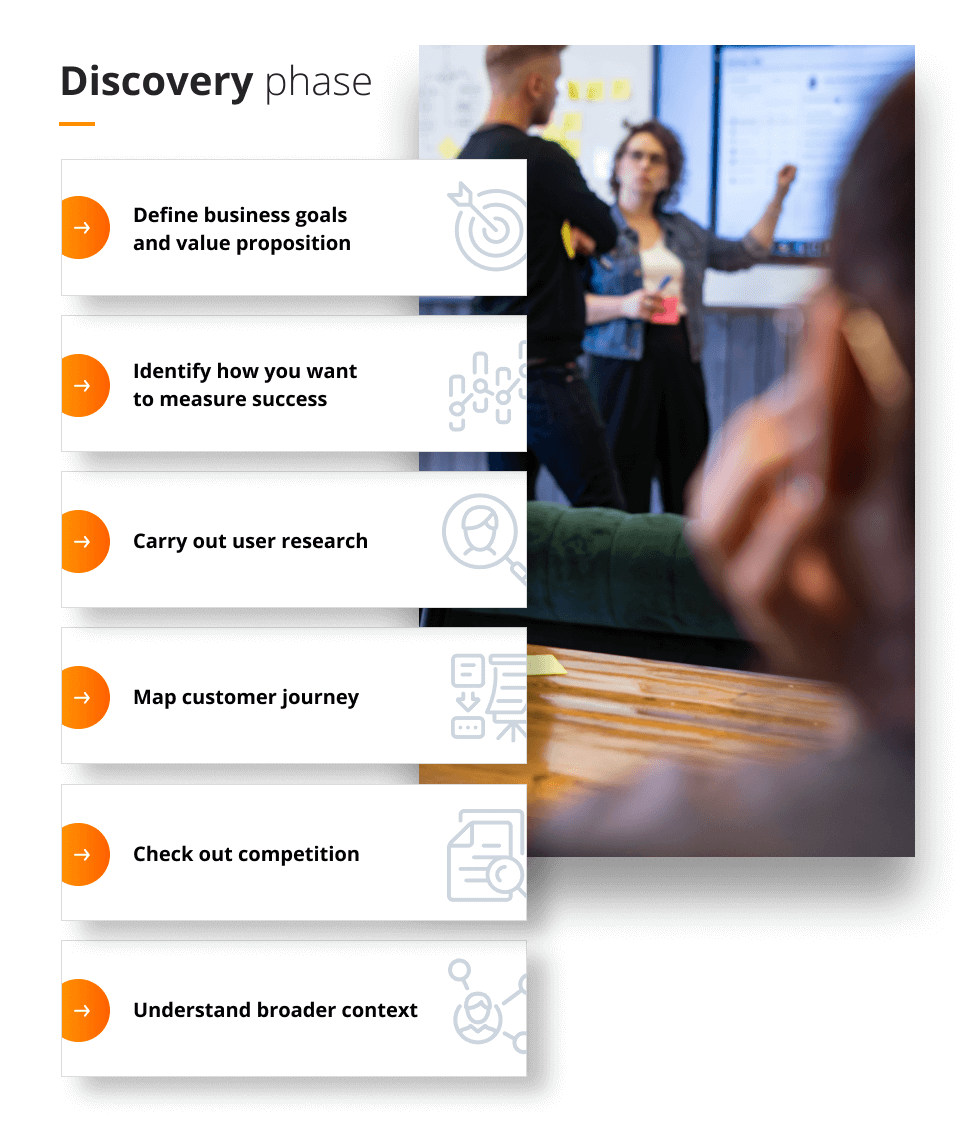
Project Discovery Phase: Setting Your Project Up for Success
Every software development process should start with the Project Discovery Phase. Today we look at what it is and how it can help you set your project up for success.
What is the Project Discovery Phase?
The Project Discovery Phase is the initial stage of the software development process where key stakeholders (including the project team and clients) work together to gather information, define project objectives, and understand the project’s scope.
By collecting and analysing information related to a project, it also helps to clarify its goals and limitations.
A good Project Discovery Strategy will be designed to collect information on the following:
the main vision and ideas behind the project;
the business goals;
business and technical requirements;
the budget and project timeline;
the intended development process;
risk assessment and prevention.
The Project Discovery Strategy plays a very important role in the overall success of every software development project which is why a robust, detailed project discovery stage is always required and so crucial.
According to research carried out by McKinsey, 45% of projects exceed their original budget with a benefits shortfall of 56% less than initially projected. It was also reported that a staggering 17% of all software development projects turn out so badly they end up being the downfall of their companies!

The importance of a Project Discovery Phase
The Project Discovery Phase is critically important for several reasons, as it plays a key role in ensuring a successful and well-executed project. It allows for clarification of project objectives, it helps in scope definition and boundary establishment, it allows to identify and mitigate potential risks that could impact the project.
It also enables the collection of requirements and documentation, resource planning, allocation and communication with stakeholders, the development team and customers.
When executed well, the project discovery phase will allow you to set your business goals accurately, control your budget and increase ROI, mitigate risks, deliver immeasurable value to your clients and generally streamline all processes to their optimum level.
All digital product companies should engage in Project Discovery Phases as part of their digital transformation and software development models as thanks to this they will experience huge benefits in their project quality and user satisfaction, and of course, financial rewards.
Find out more about the Project Discovery phase:
How can the discovery stage be powered by design thinking workshops?
How can a Scrum team work together during the discovery stage?
The essential goals of a Project Discovery Phase
As we already mentioned, the essential goals of a Project Discovery Phase are to establish a clear understanding of the project’s objectives, define its scope, identify and mitigate potential risks, gather and document comprehensive requirements, and plan for efficient resource allocation.
The discovery stage aims to align stakeholders, set realistic estimation, timelines and milestones, establish a communication plan, and, when applicable, validate ideas through prototyping or proof-of-concept models.
Overall, the Project Discovery Phase serves as the foundation for successful project execution by minimising uncertainties, preventing scope creep, and ensuring a collaborative and well-informed approach.

Who is involved in the Project Discovery team?
Although the composition of a Project Discovery team can vary depending on the nature and complexity of the project as well as on the specific requirements of the organisation, there are some typical roles usually involved in the Project Discovery Phase.
They include:
a Project Manager, responsible for project management the efforts of the team and ensuring that the objectives align with organisational goals,
Project Stakeholders including clients, sponsors, end-users, and any individuals or groups affected by or interested in the project,
and Product Owner representing the end-users and responsible for defining and prioritising product features.
Other important Project Discovery team members should include technical experts, a business analyst, designers, sponsors and legal representatives.
Collaboration among these diverse roles in this phase of a project ensures a comprehensive understanding of the project’s goals, requirements, and potential challenges.
How to conduct a Project Discovery Phase?
Let’s now look at how we can conduct a successful discovery phase.
Here are some main steps to help you do it:
Step 1: Define project objectives and scope
First and foremost, build your discovery team. The discovery team members should be as diverse as possible in order to bring to the table different perspectives and attributes. Typically, as a minimum a well-rounded team will involve a project manager, a UX/UI designer, a technical expert and a project analyst.
Once your team is set, identify all stakeholders in the software project. Think of its owners, target audience, investors, developers and so on.
Lastly, identify the business goals of the project. This helps to get a good understanding of the main purpose of the project, any possible issues that may occur, and will keep you focused on the end goal throughout the entire project.
Read more about product and project development:
What are the stages of a custom software development process?
The ultimate guide to Project Management: strategies, tools and insights
Step 2: Gather and analyse key information
This is a critical stage in the Project Discovery phase as it helps the team get a full overview of what their competitors are doing, what their target audience want and need, and what the state of the market is.
It can broadly be split into three sub-stages:
User research
Interviewing potential customers and your client is a really important foundation for understanding what kind of product or service is required. It helps to clarify any doubts and set expectations for the project scope.Market research
Once you have defined the wants and needs of your customers, the next step is to study the market. What kind of demand is there for this type of project? Does this project fit into a gap in the market that could be exploited or is the market relatively saturated?In this stage, we can set the expectations for the project and begin to create achievable benchmarks. Running market research surveys is a great way of conducting this research and will be extremely useful in helping project managers make crucial decisions on the direction the project should go.
Competitor research
Lastly, it’s very important to look at what other companies are doing and how they are doing it. Are they working in a similar niche to you or have you stumbled upon a new area?Understanding what your competition is doing and the standards they are setting in the market will help you define aspects of the project such as budget and pricing, quality control and the project roadmap.
Step 3: Present your findings and engage stakeholders
After setting your goals and gathering all of your research, it’s time to present your findings to the shareholders. For the project to be given the green light, they must be made aware of its viability, any possible roadblocks, the current state of the market and the plan for moving forwards.
This will allow the stakeholders to make a decision on whether or not to take on the project to completion, and if so, under what conditions.
Step 4: Evaluate budget and timeline
If the shareholders give you the green light, it is very important to establish the milestones of the project along with detailed budget projections. This will increase the viability of the project and is highly critical to move forward.
Alongside these, all potential bottlenecks must be identified and troubleshooting solutions need to be suggested to mitigate any negative issues down the line.
Step 5: Develop an initial project plan and roadmap
Once you have gone through all previous steps, the final preparations must be completed so that the project can begin. These will need to be communicated to the shareholders in order to get the final sign off, and bear in mind that changes and adaptations are common at this stage so it’s important to be flexible.
It may be that several steps in the Discovery Phase need to be repeated so that precise project boundaries can be made once again. Identifying and correcting issues at this stage will save much more time than if they crop up later on.
The benefits of an effective Discovery Phase
There are many benefits of conducting a well executed Discovery Phase.
Some of them are as follows:
proper risk management which leads to cost-savings and allows to meet deadlines,
better cost control – remember that 17% of all businesses fail due to going over budget and the Project Discovery Phase can help mitigate this risk,
knowing your goals which helps streamline the entire process,
UX optimisation – defining the users’ wants and needs helps to ensure the project is successful,
good business decisions – the Project Discovery Phase allows you to make good, well thought-out decisions that are based on data, not assumptions.
The benefits of carrying out a Project Discovery Phase are clear so there should be no doubt in whether or not to conduct one for your company. Not doing so puts you at risk of escalating costs, unreliable and unrealistic deadlines, never-ending scope creep and a project that doesn’t meet yours or your shareholders’ expectations.
Cost and duration of the Discovery Phase
The cost and duration of the Project Discovery Phase can vary significantly based on several factors, including the size and complexity of the project, the industry, the number of stakeholders involved, and the specific activities conducted during the Discovery Phase.
Some organisations may choose to allocate a percentage of the overall project budget to the Discovery Phase, while others may determine costs based on hourly rates for personnel involved.
In general, the Discovery Phase is an investment that can lead to great results and costs savings. It’s essential for organisations to carefully plan and budget for the Discovery Phase based on the unique characteristics of their projects.
If you are keen to know more about Project Discovery Phase or want to start your discovery process straight away, do get in touch with our team. At Future Processing we have a vast experience of working with businesses of all sizes to help them make the most out of their Discovery Phases. We will be happy to share our knowledge with you!




